Study of Semi-Solid Magnesium Alloys (With RE Elements) as a Non-Newtonian Fluid Described by Rheological Models
Abstract
:1. Introduction
2. Materials and Methods
- -
- heating the sample;
- -
- homogenising the temperature value in a whole volume of the sample—wait about 20 min after the assumed temperature value is obtained—while slowly shearing the sample;
- -
- after stabilisation of the viscosity values of totally liquid alloys—decreasing the temperature up to fs = 50% in each of alloys investigated (stirring with a shear rate 10 s−1);
- -
- homogenise the temperature value in a whole volume of the sample;
- -
- measurement with a shear rate 10–150 s−1;
- -
- cooling the sample.
3. Results
3.1. Data Description with Rheological Models
3.2. Rheoplus Calculations
3.3. Wolfram Mathematica Calculations
4. Discussion
5. Conclusions
- Rheological tests of magnesium alloys are challenging due to the high reactivity of the materials tested. They require considerable experience during measurements and analysis of the results obtained.
- Alloys E21 and WE43B contain rare earth elements (yttrium, neodymium, gadolinium), which may influence changes in the shear stress values. However, rheological tests of alloys with various contents of the above-mentioned rare earth metals would need to be performed to verify this.
- All of the alloys tested showed a tendency towards non-linear growth of the shear stress value as the shear rate grew. This is one of the key examples of non-Newtonian behaviour (shear-thinning), characteristic for metals in a semi-solid state.
- Four different rheological models: Herschel-Bulkley, Ostwald, Carreau, and Bingham provided a good level of accuracy of the description, however, the measurement data were most accurately described by the models of Carreau and Herschel-Bulkley.
- Due to a simpler mathematical form (and shear rate “range”), the model that is the most recommended for the description of data from rheological measurements of semi-solid magnesium alloys (with 50% solid phase share in the alloy) is the Herschel-Bulkley model.
- The approximation conducted for higher values of the shear rate, for the Herschel-Bulkley model, showed that the model predicted shear stress values well, in particular for alloys AZ91 and WE43B (narrow mean prediction bands). The model performs slightly worse for alloy E21, but this is likely to be as a result of the greater span of the measurement points obtained.
- The rheological models may be helpful for modelling and optimising the forming process of semi-solid magnesium alloys. Complementing thermodynamic databases with the results of rheological measurements will contribute to the development of the above mentioned processes and will facilitate modelling/engineering these processes without the need for conducting time-consuming and demanding measurements.
- During the thixocasting process the solid fraction might vary a great deal, thus, a wide range of rheological experiments have to be conducted to obtained reliable data for different amounts of liquid/solid fractions of Mg alloys. Authoritative data are also required from the optimal rheological model (for Mg alloys) point of view. The provided test with various shares of the solid and liquid phases show a similar rheological dependency as described in this paper.
Acknowledgments
Conflicts of Interest
References
- Bakhtiyarov, S.I.; Overfelt, R.A. Measurement of liquid metal viscosity by rotational technique. Acta Mater. 1999, 47, 4311–4319. [Google Scholar] [CrossRef]
- Budai, I.; Benko, M.; Kaptay, G. Comparison of different theoretical models to experimental data on viscosity of binary liquid alloys. Mat. Sci. Forum 2007, 537, 489–496. [Google Scholar] [CrossRef]
- Miłkowska-Piszczek, K.; Korolczuk-Hejnak, M. An analysis of the influence of viscosity on the numerical simulation of temperature distribution, as demonstrated by the CC process. Arch. Metall. Mater. 2013, 58, 1267–1274. [Google Scholar] [CrossRef]
- Qi, Y.; Cagin, T.; Kimura, Y.; Goddard, W.A. Viscosities of liquid metal alloys from nonequilibrium molecular dynamics. J. Comput. Aided Mater. 2001, 8, 233–243. [Google Scholar] [CrossRef]
- Zhao, P.; Wang, Q.; Liu, L.; Wei, Z.; Zhai, C. Fluidity of Mg-Al-Ca alloys in the high-pressure die casting proces. Int. J. Mater. Res. 2007, 98, 33–38. [Google Scholar] [CrossRef]
- Huppmann, M.; Reimers, W. Microstructure and mechanical properties of differently extruded AZ31 magnesium alloy. Int. J. Mater. Res. 2010, 101, 1264–1271. [Google Scholar] [CrossRef]
- Braszczyńska-Malik, K.N.; Froyen, L. Microstructure of AZ91 alloy deformed by equal channel angular pressing. Int. J. Mater. Res. 2005, 96, 913–917. [Google Scholar] [CrossRef]
- Chen, J.Y.; Fan, Z. Modelling of rheological behaviour of semisolid metal slurries Part 1—Theory. Mater. Sci. Technol. 2002, 18, 237–242. [Google Scholar] [CrossRef]
- Terzieff, P. The viscosity of liquid alloys. J. Alloys Compd. 2008, 453, 233–240. [Google Scholar] [CrossRef]
- Chhabra, R.P. A simple method for estimating the viscosity of molten metallic alloys. J. Alloys Compd. 1995, 221, L1–L3. [Google Scholar] [CrossRef]
- Flemings, M. Solidification processing. Metall. Mater. Trans. B 1974, 5, 2122–2134. [Google Scholar] [CrossRef]
- Atkinson, H.V. Modelling the Semisolid Processing of Metallic Alloys. Prog. Mater. Sci. 2005, 50, 341–412. [Google Scholar] [CrossRef]
- Kapranos, P.; Kirkwood, D.H. Thixoforming M2 tool steel—A study of different feedstock routes. Metal. Ital. 2010, 9, 17–21. [Google Scholar]
- Kapranos, P.; Kirkwood, D.H.; Sellars, C.M. Semi-Solid Processing of Aluminium and High Melting Point Alloys. Proc. Inst. Mech. Eng. Part B J. Eng. Manuf. 1993, 207, 1–8. [Google Scholar] [CrossRef]
- Sołek, K.P.; Rogal, Ł.; Kapranos, P. Evolution of Globular Microstructure and Rheological Properties of Stellite 21 Alloy after Heating to Semisolid State. J. Mater. Eng. Perform. 2017, 26, 115–123. [Google Scholar] [CrossRef]
- Rogal, Ł.; Dutkiewicz, J.; Atkinson, H.V.; Lityńska-Dobrzyńska, L.; Czeppe, T.; Modigell, M. Characterization of semi-solid processing of aluminium alloy 7075 with Sc and Zr additions. Mat. Sci. Eng. A Struct. 2013, 580, 362–373. [Google Scholar] [CrossRef]
- Brabazon, D.; Browne, D.J.; Carr, A.J. Experimental investigation of the transient and steady state rheological behaviour of Al-Si alloys in the mushy state. Mater. Sci. Eng. A Struct. 2003, 356, 69–80. [Google Scholar] [CrossRef]
- Salleh, M.S.; Omar, M.Z.; Syarif, J.; Mohammed, M.N. An Overview of Semisolid Processing of Aluminium Alloys. ISRN Mater. Sci. 2013, 2013, 1–9. [Google Scholar] [CrossRef]
- Das, P.; Samanta, S.K.; Dutta, P. Rheological Behavior of Al-7Si-0.3Mg Alloy at Mushy State. Metall. Mater. Trans. B 2015, 46, 1302–1313. [Google Scholar] [CrossRef]
- Lashkari, O.; Ajersch, F.; Charette, A.; Chen, X. Microstructure and rheological behavior of hypereutectic semi-solid Al-Si alloy under low shear rates compression test. Mater. Sci. Eng. A Struct. 2008, 492, 377–382. [Google Scholar] [CrossRef]
- Kim, W.Y.; Kang, C.G.; Lee, S.M. Effect of viscosity on microstructure characteristic in rheological behaviour of wrought aluminium alloys by compression and stirring process. Mater. Sci. Techol. 2010, 26, 20–30. [Google Scholar] [CrossRef]
- Chang, D.Y.; Kwang, S.S. Semi-Solid Processing of Magnesium Alloys. Mater. Trans. 2003, 44, 558–561. [Google Scholar] [CrossRef]
- Chen, H.I.; Chen, J.C. Thixotropic Behavior of Semi-Solid Magnesium Alloy. Solid State Phenom. 2006, 116, 648–651. [Google Scholar] [CrossRef]
- Kramer, M.; Jenning, R.; Lohmüller, A.; Hilbinger, M.; Randelzhofer, P.; Singer, R.F. Characterization of magnesium alloys for semi solid processing. In Proceedings of the 8th International Conference on Magnesium Alloys and Their Applications, Weimar, Germany, 26–29 October 2009; Kainer, K.U., Ed.; Wiley-VCH Verlag GmbH & Co. KGaA: Weinheim, Germany, 2009; pp. 376–383. [Google Scholar]
- Chen, H.-I.; Chen, J.-C.; Liao, J.-J. The influence of shearing conditions on the rheology of semi-solid magnesium alloy. Mater. Sci. Eng. A Struct. 2008, 487, 114–119. [Google Scholar] [CrossRef]
- Hu, Y.; He, B.; Yan, H. Rheological behavior of semi-solid Mg2Si/AM60 magnesium matrix composites at steady state. Trans. Nonferr. Metal. SOC 2010, 20, 883–887. [Google Scholar] [CrossRef]
- Li, L.; Zheng, M. Theoretical research on rheological behavior of semisolid slurry of magnesium alloy AZ91D. Comp. Mater. Sci. 2015, 102, 202–207. [Google Scholar] [CrossRef]
- Yan, H.; Rao, Y.; Chen, G. Rheological behavior of semi-solid AZ91D magnesium alloy at steady state. J. Wuhan Univ. Technol. 2015, 30, 162–165. [Google Scholar] [CrossRef]
- Korolczuk-Hejnak, M.; Migas, P. Analysis of Selected Liquid Steel Viscosity. Arch. Metall. Mater. 2012, 57, 963–969. [Google Scholar] [CrossRef]
- Korolczuk-Hejnak, M. Determination of Flow Curves on Selected Steel Grades in their Liquid State. Arch. Metall. Mater. 2014, 59, 1553–1558. [Google Scholar] [CrossRef]
- Ślęzak, W.; Korolczuk-Hejnak, M.; Migas, P. High Temperature Rheometric Measurements of Mould Powders. Arch. Metall. Mater. 2015, 60, 289–294. [Google Scholar] [CrossRef]
- Korolczuk-Hejnak, M. Determination of the Dynamic Viscosity Coefficient Value of Steel Based on the Rheological Measurements; Wydawnictwa AGH: Kraków, Poland, 2014; ISBN 978-83-7464-720-5. [Google Scholar]
- Ostwald, W. Ueber die Geschwindigkeitsfunktion der Viskositat Disperser Systeme. Kolloid Z. 1925, 36, 99–117. [Google Scholar] [CrossRef]
- Mezger, G.T. The Rheology Handbook: For Users of Rotational and Oscillatory Rheometers, 2nd ed.; Vincentz Network: Hannover, Germany, 2006; ISBN 3878701748. [Google Scholar]
- Wiśniowski, R.; Skrzypaszek, K. Analiza modeli reologicznych stosowanych w technologiach inżynierskich. Wiertnictwo Nafta Gaz 2006, 23, 523–532. [Google Scholar]
- Ślęzak, M. Mathematical Models for Calculating the Value of Dynamic Viscosity of a Liquid. Arch. Metall. Mater. 2015, 60, 581–589. [Google Scholar] [CrossRef]
- Korolczuk-Hejnak, M. Empiric Formulas for Dynamic Viscosity of Liquid Steel Based on Rheometric Measurements. High Temp. 2014, 52, 667–674. [Google Scholar] [CrossRef]
- Eskin, D. Modeling non-Newtonian slurry convection in a vertical fracture. Chem. Eng. Sci. 2009, 64, 1591–1599. [Google Scholar] [CrossRef]
- Eskin, D.; Miller, M.J. A model of non-Newtonian slurry flow in a fracture. Powder Technol. 2008, 182, 313–322. [Google Scholar] [CrossRef]
- Eskin, D. Modeling non-Newtonian slurry flow in a flat channel with permeable walls. Chem. Eng. Sci. 2015, 123, 116–124. [Google Scholar] [CrossRef]
- Bührig-Polaczek, A.; Afrath, C.; Modigell, M.; Pape, L. Comparison of rheological measurement techniques for semi-solid aluminium alloys. Solid State Phenom. 2006, 116, 610–613. [Google Scholar] [CrossRef]
- Modigell, M.; Pape, L.; Maier, H.R. Rheology of Semi-Solid Steel Alloys at Temperatures up to 1500 °C. Solid State Phenom. 2006, 116, 606–609. [Google Scholar] [CrossRef]

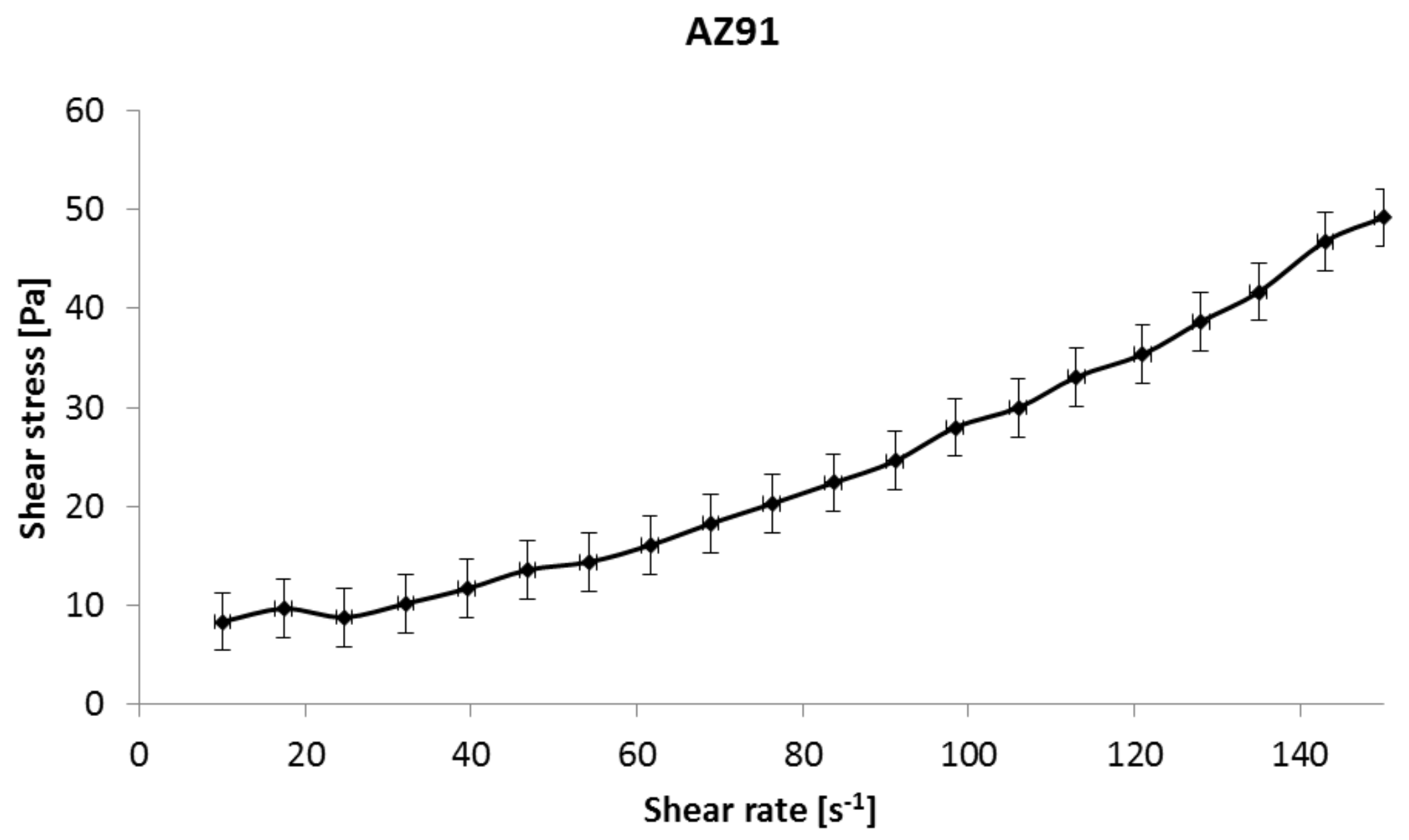
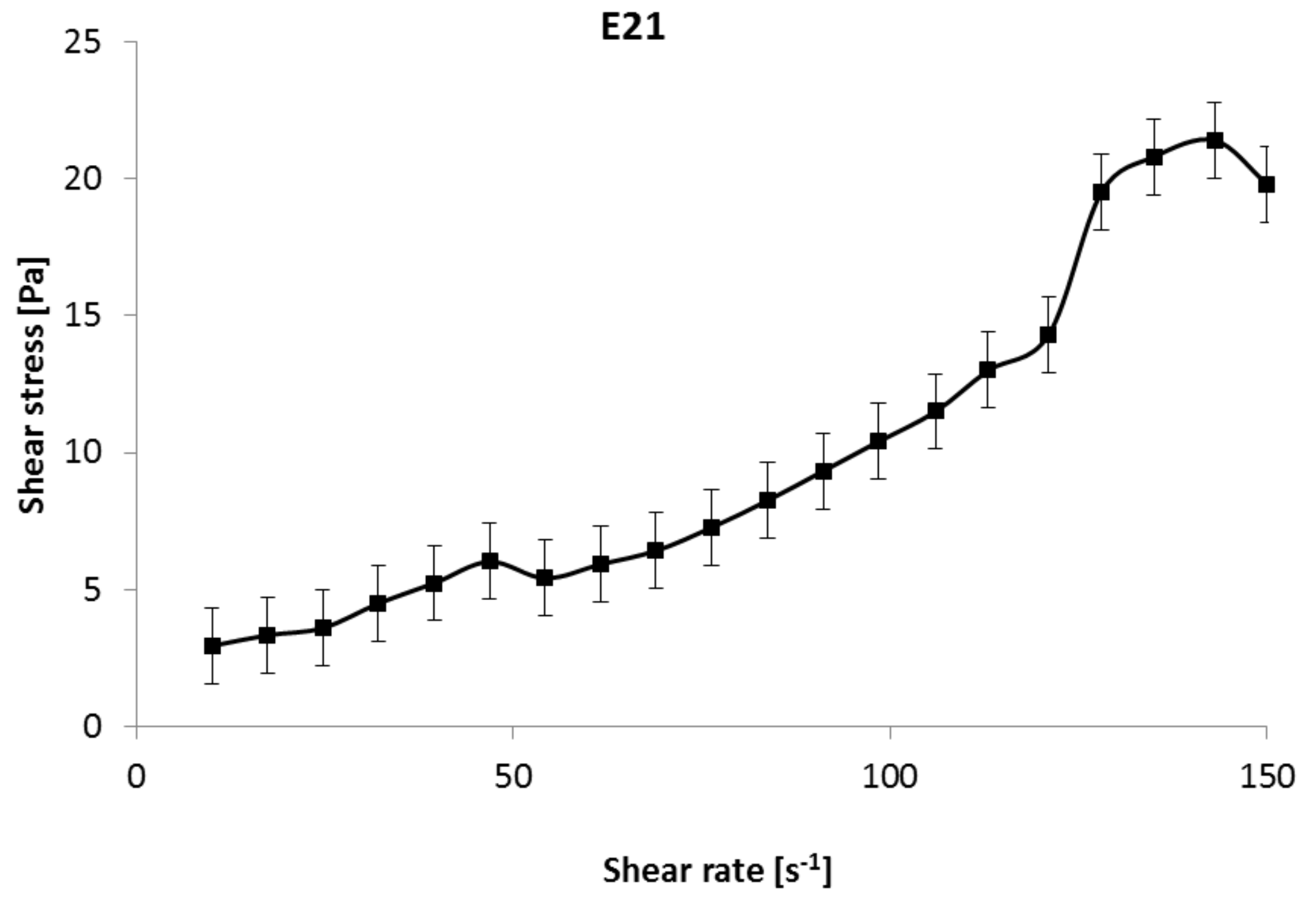
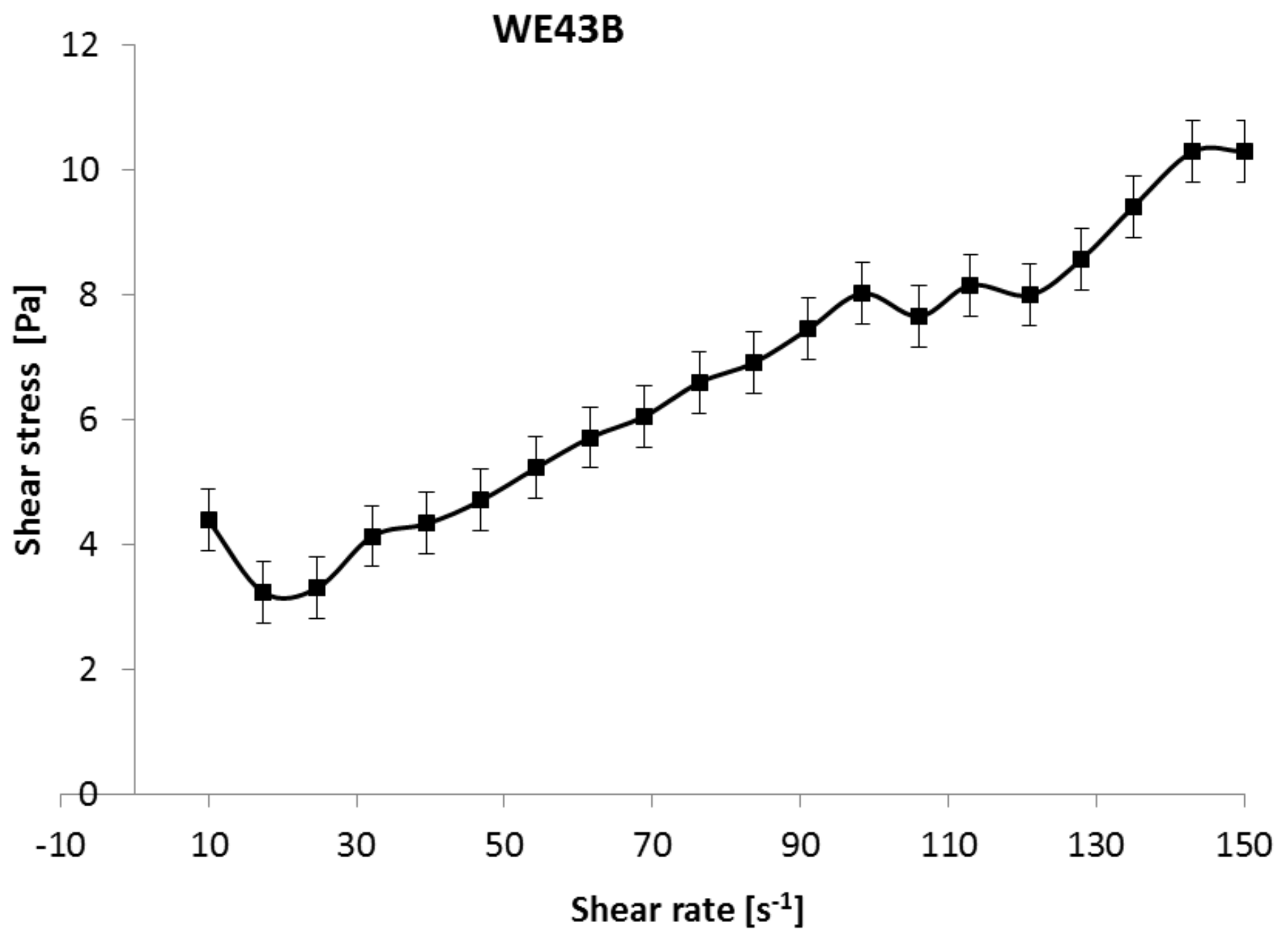
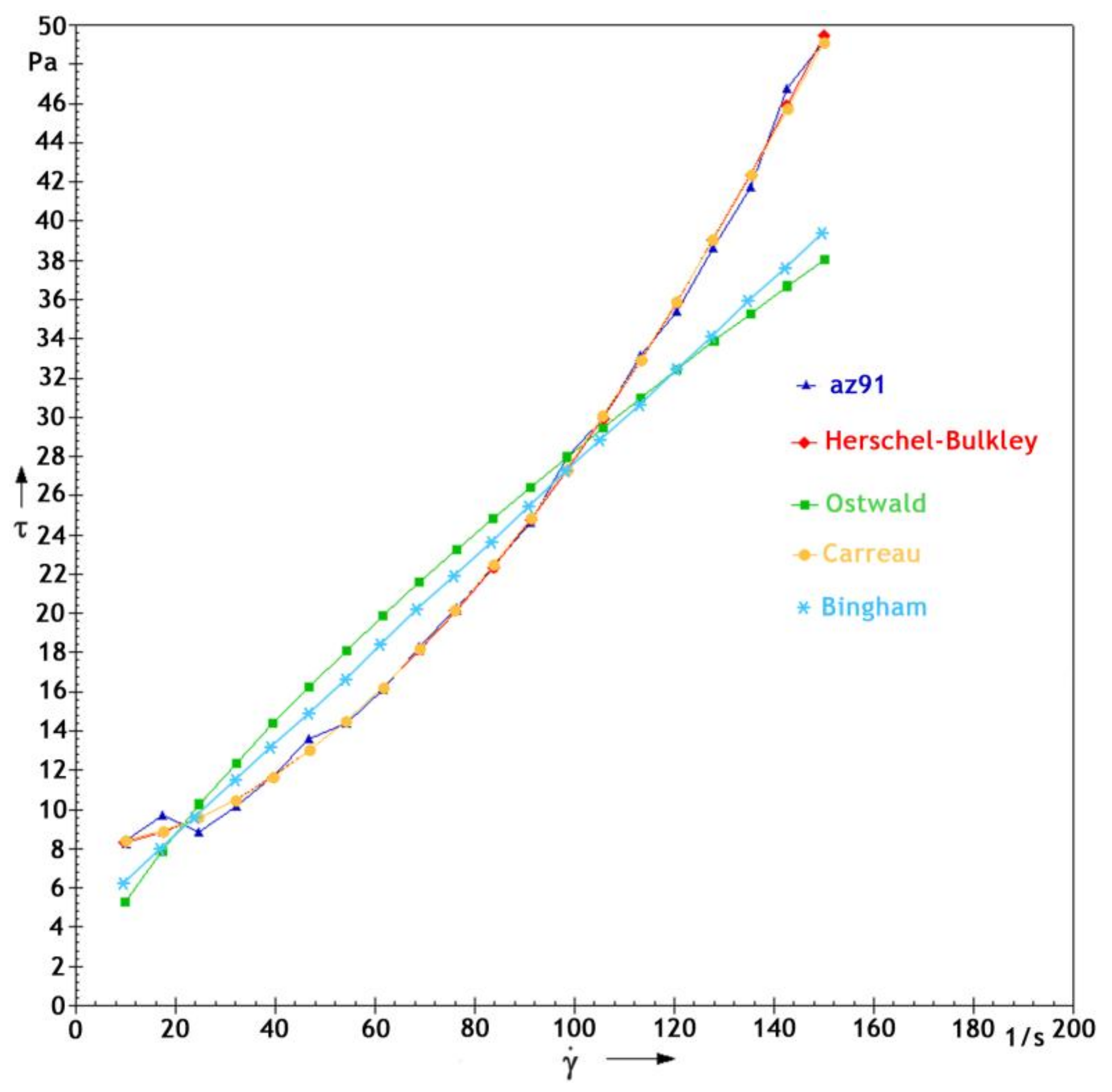
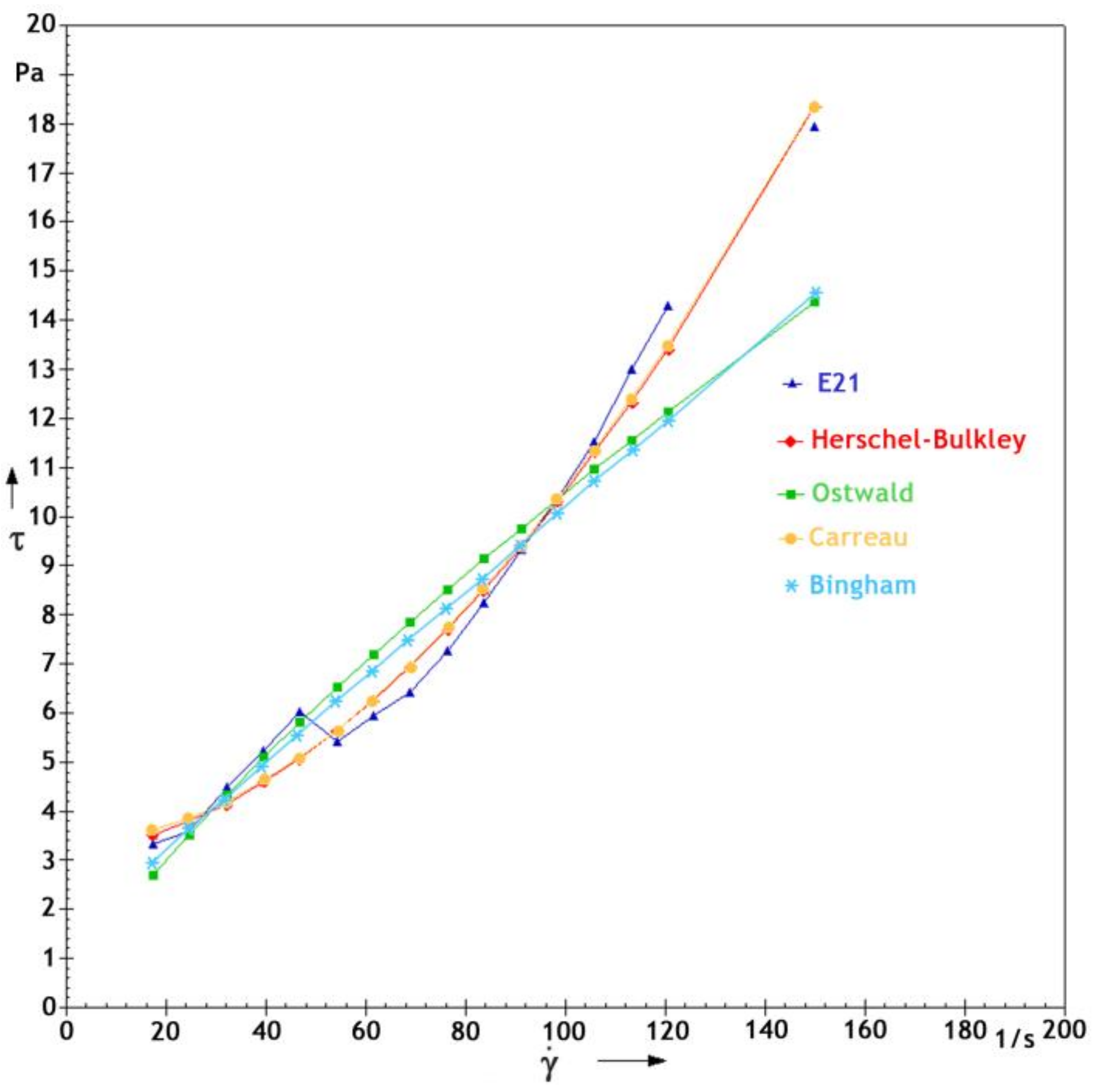


| Mg Alloy | Composition (wt %) | ||||
|---|---|---|---|---|---|
| AZ91 | Al | Mn | Zn | Mg | - |
| 8.7 | 0.13 | 0.7 | bal. | ||
| WE43B | Nd | Y | TR | Zr | Mg |
| 2.2 | 4.2 | 3.3 | 0.53 | bal. | |
| E21 | Gd | Nd | Zn | Mg | - |
| 1.4 | 3.0 | 0.31 | bal. | ||
| Mg Alloy | Liquidus Temperature (K) | T50% fs |
|---|---|---|
| AZ91 | 893 | 846 |
| WE43B | 955 | 915 |
| E21 | 947 | 918 |
| Model | Equation | |
|---|---|---|
| Herschel-Bulkley | (5) | |
| Ostwald | (6) | |
| Carreau | (7) | |
| Bingham | (8) |
| Model | Equation | |
|---|---|---|
| Herschel-Bulkley | (9) | |
| Ostwald | (10) | |
| Carreau | (11) | |
| Bingham | (12) |
| Model | Equation | |
|---|---|---|
| Herschel-Bulkley | (13) | |
| Ostwald | (14) | |
| Carreau | (15) | |
| Bingham | (16) |
© 2018 by the author. Licensee MDPI, Basel, Switzerland. This article is an open access article distributed under the terms and conditions of the Creative Commons Attribution (CC BY) license (http://creativecommons.org/licenses/by/4.0/).
Share and Cite
Ślęzak, M. Study of Semi-Solid Magnesium Alloys (With RE Elements) as a Non-Newtonian Fluid Described by Rheological Models. Metals 2018, 8, 222. https://doi.org/10.3390/met8040222
Ślęzak M. Study of Semi-Solid Magnesium Alloys (With RE Elements) as a Non-Newtonian Fluid Described by Rheological Models. Metals. 2018; 8(4):222. https://doi.org/10.3390/met8040222
Chicago/Turabian StyleŚlęzak, Marta. 2018. "Study of Semi-Solid Magnesium Alloys (With RE Elements) as a Non-Newtonian Fluid Described by Rheological Models" Metals 8, no. 4: 222. https://doi.org/10.3390/met8040222





